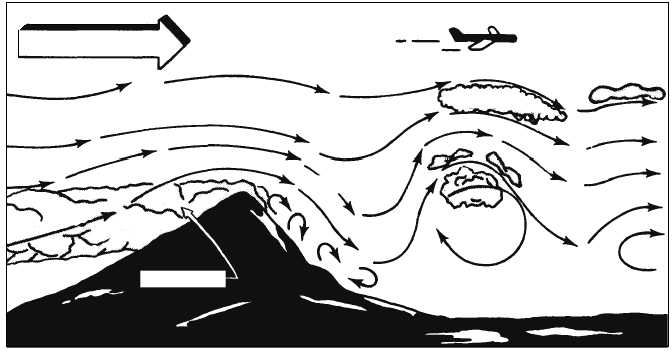amplitude and the type of the wave. The characteristics
of a typical mountain wave are shown in figure 3-31.
Figure 3-31 shows the cloud formations normally
found
with
wave
development
and
illustrates
schematically the airflow in a similar situation. The
illustration shows that the air flows fairly smoothly
with a lifting component as it moves along the
windward side of the mountain. The wind speed
gradually increases, reaching a maximum near the
summit. On passing the crest, the flow breaks down into
a much more complicated pattern with downdrafts
predominating. An indication of the possible intensities
can be gained from verified records of sustained
downdrafts (and also updrafts) of at least 5,000 feet per
minute with other reports showing drafts well in excess
of this figure. Turbulence in varying degrees can be
expected and is particularly severe in the lower levels;
however, it can extend to the tropopause to a lesser
degree. Proceeding downwind, some 5 to 10 miles from
the summit, the airflow begins to ascend in a definite
wave pattern. Additional waves, generally less intense
than the primary wave, may form downwind (in some
cases six or more have been reported). These are similar
to the series of ripples that form downstream from a
submerged rock in a swiftly flowing river. The distance
between successive waves usually ranges from 2 to 10
miles, depending largely on the existing wind speed
and the atmospheric stability. However, wavelengths up
to 20 miles have been reported.
It is important to know how to identify a wave
situation. Pilots must be briefed on this condition so
they can avoid the wave hazards. Characteristic cloud
forms peculiar to wave action provide the best means of
visual identification. The lenticular (lens shaped)
clouds in the upper right of figure 3-31 are smooth in
contour. These clouds may occur singly or in layers at
heights usually above 20,000 feet, and may be quite
ragged when the airflow at that level is turbulent. The
roll cloud (also called rotor cloud) forms at a lower
level, generally near the height of the mountain ridge,
and can be seen extending across the center of the
figure. The cap cloud, shown partially covering the
mountain slope, must always be avoided in flight
because of turbulence, concealed mountain peaks, and
strong downdrafts on the lee side. The lenticular, like
the roll clouds and cap clouds, are stationary, constantly
forming on the windward side and dissipating on the lee
side of the wave. The actual cloud forms can be a guide
to the degree of turbulence. Smooth clouds generally
show smoother airflow in or near them with light
turbulence. Clouds appearing ragged or irregular
indicate more turbulence.
While clouds are generally present to forewarn the
presence of wave activity, it is possible for wave action
to take place when the air is too dry to form clouds. This
makes the problem of identifying and forecasting more
difficult.
3-28
AG5f0331
STRONG WINDS
TURBULENT LAYER
LENTICULAR
WINDS
CAP CLOUD
TURBULENT
ROLL
CLOUD
Figure 3-31.—Schematic diagram showing airflow and clouds in a mountain wave.


